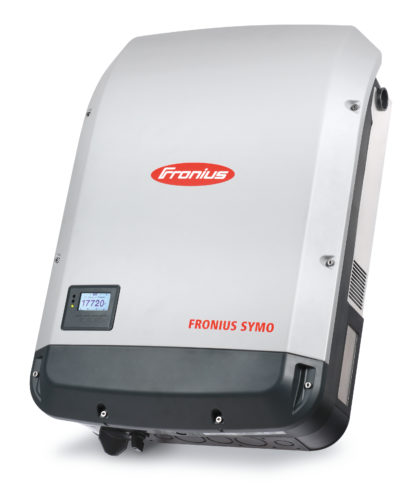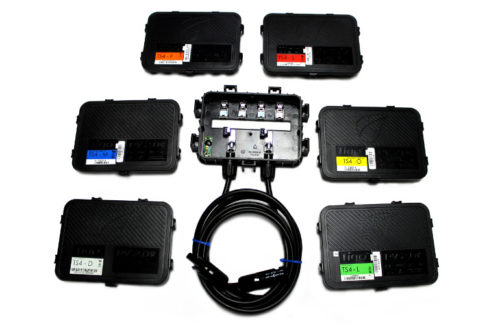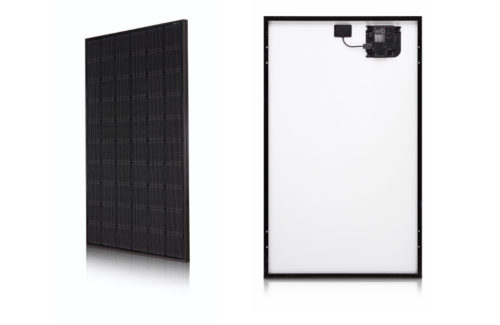The Section 690.12 update to the 2017 National Electrical Code (NEC) calls for module-level rapid shutdown of solar systems instead of NEC 2014’s array-level shutdown requirement. Starting Jan. 1, 2019 when NEC 2017 goes into effect in certain jurisdictions, all conductors within an array’s 1-ft boundary have to be reduced to 80 V or less within 30 seconds of rapid shutdown initiation.
Smart modules, microinverters and other module-level power electronics (MLPEs) assist solar systems with module-level rapid shutdown. Here are the products that can bring solar projects installed after Jan. 1, 2019 to compliance with NEC 2017 module-level rapid shutdown.
Optimizers, smart modules and flexible MLPEs
Whether a panel comes pre-attached with optimizers or other MLPEs as a smart module or installers have to attach them in the field, these DC devices can be module-level rapid shutdown-compliant.
When rapid shutdown is required on systems with these DC products, the AC breaker is flipped, and the loss of power causes the module-level electronics to turn off and suspend voltage output.
The LG NeON R smart module solution, which consists of SolarEdge inverters, SolarEdge power optimizers and LG modules, is one example of a smart module in compliance with NEC 2017 rapid shutdown requirements. When the system loses AC power, the inverters turn off and the power optimizers start to safely draw down power.
Tigo is a seasoned power optimizer manufacturer, but the company’s solutions have evolved past just optimizing individual solar panels. The company’s TS4 platform offers many more module-level options, such as monitoring or fire safety. These flexible MLPE (Flex MLPE) products take the place of standard bypass diodes in the junction box and allow all types of modules—like Trina Solar’s TrinaSwitch—to meet module-level shutdown compliance without additional external boxes. Many inverters are also UL-listed to work with Tigo’s TS4 to be in compliance with NEC 2017.
SMA is one of those inverter companies. The SMA Sunny Boy inverters communicate with Tigo’s Cloud Connect Advanced (CCA) universal dataloggers to talk to the optimizers in the case of an emergency.
“The PV system rapid shutdown initiator is the main AC service breaker,” said Mike Mahon, solar academy trainer at SMA America. “The loss of communication at the TS4 devices in conjunction with the cessation of output power of the PV inverter triggers the TS4 devices to isolate their modules from the series string.”
When the AC circuit breaker is disconnected within a Tigo system, the loss of power from the grid causes the inverter and the CCA to turn off. When these two things shut off, the TS4 devices automatically enter rapid shutdown mode so output voltage and power turn off completely.
With all DC-based MLPEs assisting with rapid shutdown, the AC breaker is the only switch to flip. No extra button is needed to confirm that voltage is shut down for first responders or others wanting to turn off an array.
Microinverters and AC modules
Rapid shutdown occurs similarly for microinverters and optimizers: The AC breaker is the only switch to flip for the solar system to shut down.
“When the main breaker is shut off, all microinverters immediately shut off and all conductors and wiring are de-energized,” said Surya Potharaju, senior director of product management at microinverter manufacturer Enphase Energy. “Put another way, the UL 1741 inverter compliance requires that inverters cease operation whenever the utility parameters fall out range. Shutting off the main breaker places the utility voltage and frequency out of range.”
Microinverters ship rapid-shutdown-compliant and no additional components are needed. The same can be said about AC modules with microinverters already attached.
Product compliance
Having module-level devices like optimizers, microinverters and flexible MLPEs means nothing to the rapid shutdown conversation if they cannot communicate with the string inverter or main AC connection.
 The SunSpec Alliance, a trade group formulating standards to enable plug-and-play systems, established the SunSpec Communication Signal for Rapid Shutdown Interoperability Specification that defines a communication protocol for module-level rapid shutdown. When modules, MLPEs and inverters achieve this specification, it is a guarantee to solar installers that the products will interact with each other to achieve shutdown when initiated.
The SunSpec Alliance, a trade group formulating standards to enable plug-and-play systems, established the SunSpec Communication Signal for Rapid Shutdown Interoperability Specification that defines a communication protocol for module-level rapid shutdown. When modules, MLPEs and inverters achieve this specification, it is a guarantee to solar installers that the products will interact with each other to achieve shutdown when initiated.
Fronius was the first inverter company to announce its Symo Advanced inverter complied with the SunSpec guidelines for rapid shutdown communication over power lines. As long as the modules and/or MLPEs in the solar system are also SunSpec-certified, then the Fronius Symo Advanced inverter can assist with module-level rapid shutdown.
SMA and Tigo released a module-level rapid shutdown unit that is also SunSpec-certified. Tigo’s TS4-F (Fire Safety) device is purely a shutdown device and does not offer other optimizing features. SMA plans to bring all its U.S. string inverters in full compliance with the SunSpec rapid shutdown specification before Jan. 1, 2019.
ABB also has some of its products SunSpec-certified, and many other manufacturers are working to meet requirements before NEC 2017 goes into effect.






Does 690.12 apply to 12v DC off-grid buildings?
This is simple to do but they want to make it complicated. I submitted plans to the city of Hayward that I have a enclosure in my attic where the DC comes in after passing through my Soladeck. This enclosure has a Allen Bradley relay (real industrial) I got from work that is open when the power at the main is off
and close when the main and is on. It is feed from a 15 amp breaker. So if the fire department open my 100 amp breaker located at my utility meter, the 240 volts is cutoff and simultaneously the Allen Bradley
breaker will open and the DC voltage from the solar panels is stopped within 1 foot of the panels. Easy for a 30 year controls guy but a city work who never wired anything can’t understand.
They just want you to spend money on some commercial product that does the same thing.
According to the article: any time the rapid shutdown system is activated (either via an initiation device or a power outage), the Tigo TS4 devices “automatically enter rapid shutdown mode so output voltage and power *turn off completely*.”
Please note, however, according to the TS4 installation manual: “All TS4-F units start in the OFF position and measure 0.6V at the output. When power is supplied to the RSS Transmitter, the TS4-F units turn ON and allow full PV module voltage. The units constantly receive a “keep-alive” signal from the transmitter over PLC. When power to the transmitter is cut, this keep-alive signal ceases, sending every TS4-F into shutdown mode with *output reduced to 0.6V*.”
(https://www.tigoenergy.com/library/view/Installation+Manual+-+TS4-F%2C+TS4-R-F%2C+TS4-A-F%2C+RSS+Transmitter.pdf/)
That’s to say, rapid “shutdown” is a bit of a misnomer—since the string will still have detectable voltage even after the rapid shutdown system is activated. Perhaps a better name would be rapid “voltage reduction to touch-safe level”? (although that doesn’t quite roll off the tongue as easily as “shutdown”)
The system is shutdown, modules are no longer coupled in series/parallel connections and no deadly current will flow; ergo rapid shutdown. NEC 2017 defines this as 80v or less in 30 seconds.
What does the controlled cable mean or to which is the controlled cable refer in NEC 690.12(B)(1)?
Controlled conductor refers to the conductor being controlled by the rapid shutdown means. In other words its your DC home runs from the array.
Has anyone tried the IMO FireRaptor? This is low cost and VERY easy to install and more than complies with NEC2017
I found this link:
https://imopc.com/pages/fireraptor
I’ve use this in a few applications – for the price, not back at all. Its also UL approved – plug and play out of the box.
Batteries are well covered in all the rapid shutdown articles, but what about batteries? What are the RSS requirements for batteries in a PV system? De-energizing the array and grid is one thing, but if the battery is still active, most of the house could still be energized.
Battery systems (BESS) are often required by AHJs to have readily accessible DC disconnecting means and appropriate labeling within visible line of sight of the battery cabinets or enclosures. Automatic whole-system rapid shutdown via an emergency power off (EPO) button or EPO system is not yet required, but will likely be coming in future code cycles as BESS become widespread. There has to be a way for a system with battery backup power to differentiate between loss of AC power due to a power outage, in which case the system must remain energized to provide standby power to the facility, vs. loss of power due to a fire event and AC power disconnection by the fire department. I’m designing EPO systems on all of my multi-source projects these days and educating the local fire district on their presence and use during an emergency.
Is rapid shutdown applicable to solar carports?
No. Not required unless the carport could somehow be considered to be “building integrated”, like on a parking structure for example. Not required for a carport mounted to the ground.
Here’s a good code based write-up on the subject: https://www.purepower.com/blog/urgent-rapid-shutdown-increases-project-costs-starting-jan-1-2019
In all the discussions I see about the issue of rapid shutdown the focus of attention is on the array and MLEPs . In the article above the actual trigger for this shutdown is assumed to be the main breaker but unless your service panel and main breaker are on the outside wall of your house near your meter this will not meet the requirements for Rapid Shutdown NEC 2017 that go into effect on Jan.1 2019.
690.12(B)(2)
(C) Initiation Device. The initiation device(s) shall initiate the rapid shutdown function of the PV system. The device “off” position shall indicate that the rapid shutdown function has been initiated for all PV systems connected to that device. For one-family and two-family dwellings, an initiation device(s) shall be located at a readily accessible location OUTSIDE, (my emphasis), the building. The rapid shutdown initiation device(s) shall consist of at least one of the following:
(1) Service disconnecting means
(2) PV system disconnecting means
(3) Readily accessible switch that plainly indicates whether it is in the “off” or “on” position.
I wish a bit more attention had been given to this aspect of meeting the requirements. The local AHJ may approve a system with the initiator inside the basement where the vast majority of service panels reside but assuming so is a gamble.
Realistically, these typically California-style requirements will only lessen the number of solar installations, when what everyone knows, is that we have to build out solar in every place where we use energy. Open the flood gates, not restrict them. One or the other, not both simultaneously.
Robert
Not correct,Robert.
The changes are in favor of smart modules,optimizers and microinverters.
The normal string inverters systems have to battle with them.
However,many companies are now working how to link the panels and the inverters via new devices ,as not to let the fore-listed to become monopolist and to control the market.
Hello Kelly. I am searching for a FRONIUS SYMO 15.0-3 208 Maximum 50A input current and 1 MPPT a RAPID SHUT DOWN solution.
Regards
Uli
Hi Ulrich, Solar Power World is a publication, so please reach out to Fronius directly for specifics on its product.
The 2017 NEC does NOT require module level rapid shit down. 690.12 does restrict the distance outside of the array that conductors can travel, but array level rapid shutdowns are acceptable. Module level RSDs meet this requirement as well but are not the exclusive answer.
2017 does require safety within the array starting Jan 1. This article is focused on 690.12(B)(2) “Inside the Array Boundary” – you only mention the “Outside the Array Boundary” requirement, and an array level shutdown won’t help. This article is also only focused on method (2) – not more than 80V within boundary. However, method (1) Hazard Control via UL 3741 or method (3) no exposed wiring or grounded metal parts (a.k.a. the Dow exception) are also allowed.
690.12.b.2 choose one:
690.12.b.2.1 RSS-listed devices needn’t shutdown the circuits inside the boundary, such as a RSS combiner box
690.12.b.2.2 Arrays not using listed RSS devises need module level controls.
690.12.b.2.3 non-metal BIPV over 8′ height
You might use option 1 if dc-coupling a rooftop array to a charge controller or on a commercial project. Option 2 is by far more popular. Option. 3 shows us how it’s pretty bad code. All the solar fires I know of are not rapid shutdown issues, but rather deal with rooftop conduit runs and lack of expansion joints on non-floating arrays.
Yes solar safety shutoff exceeds nec and has a granted us patent. We are looking for partners as this product can be fitted to any new or existing solar array
The current solution is more like using AC relay in parallel with MOSFET. It will be not a physical disconnect. To trigger the AC breaker is also getting very expensive. We have offered a DC 600A 13A/15A minature relay can easily helps design to physically disconnect the solar panel to the inverter.
Will only MPLE pv technology survive after 2018 due to NEC 2017 module-level rapid shutdown?
so basically only the “older” style of installs would need the rap shut down? EX modules to combiner direct to inverter? No micros or optimizers used.
All solar projects installed after Dec. 31, 2018, in specified jurisdictions will need to be rapid shutdown compliant.
you completely omitted multimode and grid isolated
Another far safer way is by use of the solar safety shutoff
This system provides full module level isolation providing a 4mm air gap across each string via an electro magnetic safety system. Unlike all systems you mentioned it can be easily retrofitted to any existing system and is not susceptible to failure by overvoltage or lightening
Joe – is your product in compliance with NEC 2017 requirements?
Joe, Can you send specific details? I work with a lot of existing systems.
Hi Ron
Could you forward your enquiry to our website so we may attend to your needs